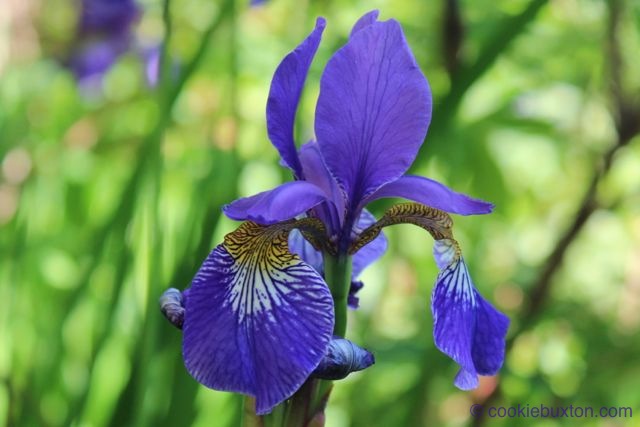Blue Flag
Iris versicolor. Blue Flag.
These stately plants really do look regal, in keeping with the use of the fleur-de-lis (or de-lys) over the centuries to signify French royalty. In Canada, the Blue Flag is the provincial flower of Quebec.
The Blue Flag plants in my garden are “legacy” plants that I inherited from my mother-in-law when my husband and I bought her home 19 years ago. She had her irises growing beautifully along a south wall in a hot dry garden bed – not at all a typical location, as this iris grows in the wetlands and marshes in the wild. I don’t remember why I needed to move the plants, but I did, and my flag irises now grow in a raised bed hemmed in between a shrub rose that has grown vigorously in the past two years, and layers of virginia creeper that grow thickly along the fence. Even so, the Blue Flag is healthy. The blooms are lasting well (spring was late, and the weather has been on the cooler side), even though the plants have dry feet and are competing for water with lots of heavy drinkers nearby. They are situated in a partially shaded location, which keeps the soil from getting bone dry.
I have to intentionally go around the side of my house to view my irises, and so I make a point in the spring of watching carefully for them, and then spending time each day once the flowers open to walk around the corner to see them in bloom. (That is quite a bit of effort for a Spare Time Gardener.) These plants are so very beautiful. I will leave the plant experts to describe the spiked leaves in a proper manner, and to describe the petals in scientific terms. I simply encourage you to drink in the beauty of these plants as I do. To look at these plants is kind of like drinking water on a hot day – there is nothing better to do in that moment.
Seen in the sunlight or shade, the richness of the colours and the veining on the petals are exquisite.
I’ve read that the iris image on flags, such as that for the Province of Quebec, in Canada, comes from the flag iris, although it is the Iris pseudacorus, or Yellow Flag, that is more likely to be the original inspiration. To read more on that subject, you might enjoy an article called The Fleur-de-Lys (© 1995-2003, François R. Velde). Writing about the origin of the image, the author confidently states: “I dismiss all non-floral origins as fanciful.” What a charming expression of opinion. Velde’s article offers an interesting read, as it includes references to the botanical world while drawing on the author’s understanding of heraldic language and symbols.
Photo: NK
Copyright: www.cookiebuxton.com
